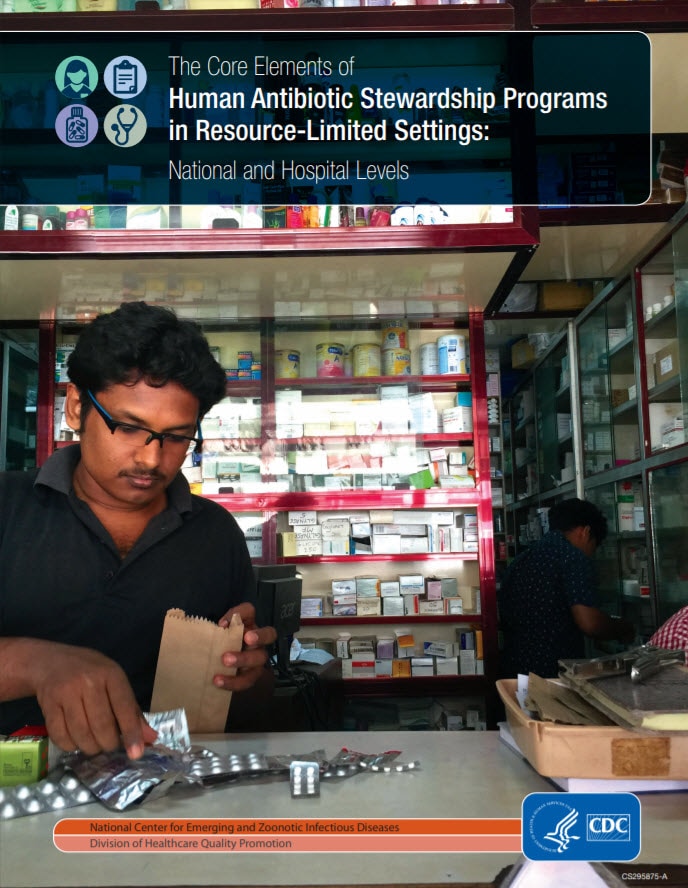CDC Core Elements to Help Resource-limited Settings Improve Antibiotic Use
Posted On: November 2018
- In 2018, CDC released the Core Elements of Human Antibiotic Stewardship Programs in Resource-Limited Settings: National and Facility Levels.
- This Core Elements is a guide for antibiotic stewardship program implementation in resource-limited settings that have fragile health systems and lack robust, regulatory frameworks. It provides practical, high-impact strategies to improve antibiotic use and fight antibiotic resistance.
- The guide builds off the Core Elements resources originally created for U.S. healthcare settings to outline structures and functions associated with effective programs.
CDC’s Core Elements of Human Antibiotic Stewardship Programs in Resource-Limited Settings: National and Facility Levels is a guide for antibiotic stewardship program implementation in resource-limited settings that have fragile health systems and lack robust, regulatory frameworks. This 2018 publication is part of CDC’s commitment to the AMR Challenge, a yearlong effort to encourage leaders from around the world to take actionable steps that advance the fight against antibiotic resistance.
Antibiotics save lives and are powerful tools for treating serious infections. However, any time antibiotics are used, it can promote the development of antibiotic-resistant bacteria. In many countries, antibiotics can be purchased over the counter without a prescription and patients frequently receive inappropriate antibiotics from healthcare providers. With global antibiotic consumption on the rise, we need to ensure that antibiotics are available to treat infections and sepsis, while at the same time ensuring antibiotics are used only when appropriate.
New Core Elements Offer Strategies for Antibiotic Stewardship Programs
Antibiotic stewardship programs aim to improve antibiotic use, improve patient outcomes, reduce costs, and combat antibiotic resistance. Implementing stewardship programs in resource-limited settings is challenging for a variety of reasons, including that most guidance is for high-resource settings.
This Core Elements provides practical, easy-to-implement stewardship strategies that have high impact for settings that might have limited resources to improve antibiotic use and fight antibiotic resistance. The guide discusses national-level policies and programs grouped by capacity and resources needed to ensure that they are feasible and sustainable. National-level activities are a critical compliment to the activities that are undertaken in hospitals and other health care facilities. At the facility-level, the guide presents a practical, stepwise framework for acute care facilities to develop antibiotic stewardship programs.
Looking Forward
Many resource-limited settings face challenges to implementing all antibiotic stewardship programs activities recommended by global or local public health agencies—but meaningful steps toward implementing national antibiotic stewardship programs are possible in any setting. While the Core Elements are not an exhaustive list of approaches to antibiotic stewardship, it serves as a starting point for stakeholders. Countries and facilities will gain expertise as they develop and implement their own antibiotic stewardship programs, and these experiences can be shared to help improve antibiotic use globally.
The international Core Elements framework was built upon the success of domestic Core Elements in the U.S. In 2014, CDC called on hospitals in the U.S. to implement antibiotic stewardship programs and created the Core Elements of Hospital Antibiotic Stewardship Programs to outline structures and functions associated with effective programs. In just three years, 4,992 acute care hospitals responded to the 2017 NHSN Annual Hospital Survey, and 3,816 (76.4%) of those hospitals reported uptake of all seven core elements.
Building on this framework, CDC released the following guides for other healthcare settings:
- The Core Elements of Antibiotic Stewardship for Nursing Homes (2015)
- The Core Elements of Outpatient Stewardship (2016)
- Implementation of Antibiotic Stewardship Core Elements for Small and Critical Access Hospitals (2017)
Today, the Quality Innovation Network Quality Improvement Organizationsexternal icon (QIN-QIOs) are working with 7,629 outpatient settings across the country to implement Core Elements of Outpatient Antibiotic Stewardship. The QIN-QIOs targeted the following outpatient facilities: physician offices, outpatient pharmacies and clinics, emergency departments, urgent care clinics, and Federally Qualified Health Centers. As of August 5, 2018, 5,137 outpatient settings across the country were implementing all four outpatient Core Elements.
